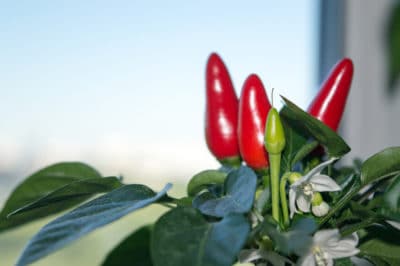Container
Hot pepper plants take an average of 100 days to reach maturity. They top out at three to four feet tall. Plants will have the same amount of biomass below the soil and above the soil. This means the size of the roots will roughly match the amount of foliage. This is a good visual measure for knowing how large the container should be.
Pot peppers plants in 1-3 gallon pots. If you intend on keeping the plant as a perennial, consider using a larger pot. Use a high quality potting soil that has peat or coconut coir as a base. Here is a recipe for making your own:
- Peat or coconut coir
- Screened compost
- Perlite or vermiculite
Mix all of the above ingredients together in equal parts. The compost will feed the plant over the long-term.
Planting and Care
Always keep pepper plants in a temperature range of between 65-75°F (18-23°C). Exposure to temperatures outside of this range can cause plants to stunt. Keep soil evenly moist at all times during germination and growth. Stick to a regular watering schedule and avoid overwatering peppers. Soil should be damp but not wet and able to drain any excess moisture.
Seedlings will sprout in 4-7 days and should immediately go underneath fluorescent lighting after sprouting. Providing artificial light to young indoor seedlings prevents plants from stretching out and requiring more staking.
Fruiting and Harvest
Feed pepper plants when they begin to fruit. When fruits are small, apply an organic liquid fertilizer. Amendments high in calcium are of particular benefit to pepper plants. Peppers tend to suffer from calcium deficiency. Avoid high nitrogen fertilizers and mix oyster shells or lime into the soil to prevent blossom end rot.
Harvest hot peppers at any stage. Harvest when green for crisp, milder fruits. If left to mature, most hot peppers will turn varying shades of red, yellow, orange, and purple. Harvesting fruits will encourage the plant to produce more.
Storage and Preservation
Store hot peppers in a plastic bag in the fridge for up to two weeks. Peppers can be preserved in many different ways including:
- Canned
- Frozen
- Dried
- Pickled
Any of these methods will preserve your indoor pepper harvest for months. Can peppers as salsa or a fiery sauce for ease of use later. Dry them and create homegrown crushed pepper flakes and chili powder.
